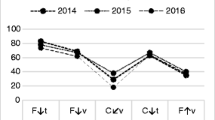Abstract
One way to fascinate, engage, arouse curiosity, motivate, and stimulate intellectual development in learning scientific concepts is to use counterintuitive questions. These questions make students aware of the inadequacies of their own thinking by exposing them to situations whose outcomes are inconsistent with what they would expect. In this study, a counterintuitive dynamics test (CIDT) is developed and administered to high school students along with the force concept inventory (FCI). After expert reviews, the initial version of the test consisting of 39 questions was administered to 87 students as a pilot study. After item analysis, a final version of 30 questions was developed; its internal consistency reliability coefficient was calculated as 0.826. The CIDT and FCI were administered to 229 students from 9 different high schools in Turkey. The results indicated that while in FCI students were mostly affected by everyday experiences and while in CIDT by carelessness and a superficial approach. Average scores for both tests were roughly equal and low. The results showed that the CIDT is a new test that measures another dimension of dynamic concepts and should be used along with the FCI.


Similar content being viewed by others
References
Alvermann, D. E., Hynd, C. R. & Qian, G. (1995). Effects of interactive discussion and text type on learning counter-intuitive science concepts. Journal of Educational Research, 88(3), 146–154.
Balta (2009). Kritik düşünme gerektiren fizik sorulari ve bunlarin öğrencilerin başarisina etkisi [Counterintuitive physics problems and the effect of these problems on student success] (Unpublished master’s thesis). Gazi University, Ankara, Turkey.
Balta, & Moğol, S. (2008). Kritik düşünme gerektiren fizik soruları ve bunların uygulamaları üzerine bir çalışma [Counterintuitive physics problems and the effect of these problems on student success]. Paper presented at the VIII National Science and Mathematics Educational Congress, Bolu, Turkey.
Bal, Z. & Moğol, S. (2010). Sezgiye ters elektrik soruları ve bunların öğrenci başarısına etkisi [Counterintuitive electricity problems and their effect on student success] (Unpublished master’s thesis). Gazi University, Ankara, Turkey.
Berlyne, D. E. (1960). Conflict, arousal, and curiosity. New York, NY: McGraw Hill.
Campanario, J. M. (1998). Using counterintuitive problems in teaching physics. The Physics Teacher, 36(7), 439–441.
Ding, L. & Beichner, R. (2009). Approaches to data analysis of multiple-choice questions. Physical Review Special Topics - Physics Education Research, 5(2), 1–17.
Everett, L. J. & Pennathur, A. (2007). A design process for conceptually based, counterintuitive problems. Paper presented at the national conference of the ASEE, Honolulu, Hawaii.
Forrester, J. W. (1971). Counterintuitive behavior of social systems. Theory and Decision, 2(2), 109–140.
Gordon, M. (1991). Counterintuitive instances encourage mathematical thinking. Mathematics Teacher, 84(7), 511–515.
Guzzetti, B. J. (2000). Learning counter-intuitive science concepts: What have we learned from over a decade of research? Reading & Writing Quarterly, 16(2), 89–98.
Hake, R. (1998). Interactive-engagement vs. traditional methods: A six-thousand-student survey of mechanics test data for introductory physics courses. American Journal of Physics, 66, 64–74.
Hestenes, D. & Halloun, I. (1995). Interpreting the force concept inventory, a response to March 1995 critique by Huffman and Heller. The Physics Teacher, 33, 502–506.
Hestenes, D. & Wells, M. (1992). A mechanics baseline test. The Physics Teacher, 30(3), 159–166.
Hestenes, D., Wells, M. & Swackhammer, G. (1992). Force concept inventory. The Physics Teacher, 30, 141–158.
Hynd, C. R., McNish, M. M., Qian, G., Keith, M., & Lay, K. (1994). Learning counterintuitive physics concepts: The effects of text and educational environment (National Reading Research Center Report No. 16). Retrieved from http://www.eric.ed.gov/PDFS/ED374404.pdf.
Kim, E. & Pak, S.-J. (2001). Students do not overcome conceptual difficulties after solving 1000 traditional problems. American Journal of Physics, 70, 759–765.
Lesser, L. M. (1994). The role of counterintuitive examples in statistics education (Unpublished doctoral dissertation). University of Texas, Austin, TX.
Maylone, N. J. (2000). Using counterintuitive problems to promote student discussion. Mathematics Teaching in the Middle School, 5(8), 542–546.
McDermott, L. C., Shaffer, P. S. & Somers, M. D. (1994). Research as a guide for teaching introductory mechanics: An illustration in the context of the Atwood’s machine. American Journal of Physics, 62(1), 46–55.
Mohazzabi, P. & Greenebaum, B. (2011). Counterintuitive behaviour of a particle under the action of an oscillating force. Physics Education, 46, 215–218.
Nieminen, P., Savinainen, A. & Viiri, J. (2010). Force concept inventory-based multiple-choice test for investigating students’ representational consistency. Physical Review Special Topics - Physics Education Research, 6(2), 020109.
Russell, Y. I. & Gobet, F. (2013). What is counterintuitive? Religious cognition and natural expectation. Review of Philosophy and Psychology, 4(4), 715–749.
Singh, C. (2002). When physical intuition fails. American Journal of Physics, 70(11), 1103–1109.
Acknowledgments
The authors wish to thank physics teachers Mustafa Demir, Ahmet Taşova, Ender Babal, Ayhan Uslu, Mücahit Akgün, Sefer Doğan, Cemalettin Karabıçak, Taylan Aktuğ and Ömer Faruk Yıldız for their careful administration of both tests at their classes.
Author information
Authors and Affiliations
Corresponding author
Appendix: Counterintuitive Dynamics Test
Appendix: Counterintuitive Dynamics Test





Rights and permissions
About this article
Cite this article
Balta, N., Eryılmaz, A. Counterintuitive Dynamics Test. Int J of Sci and Math Educ 15, 411–431 (2017). https://doi.org/10.1007/s10763-015-9694-6
Received:
Accepted:
Published:
Issue Date:
DOI: https://doi.org/10.1007/s10763-015-9694-6




